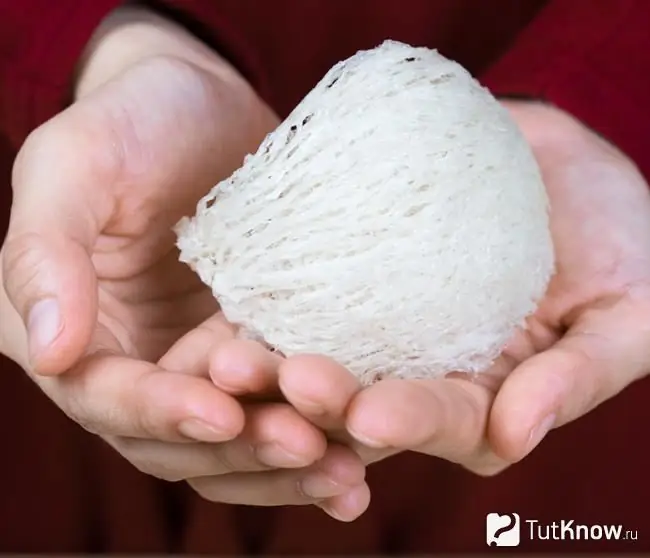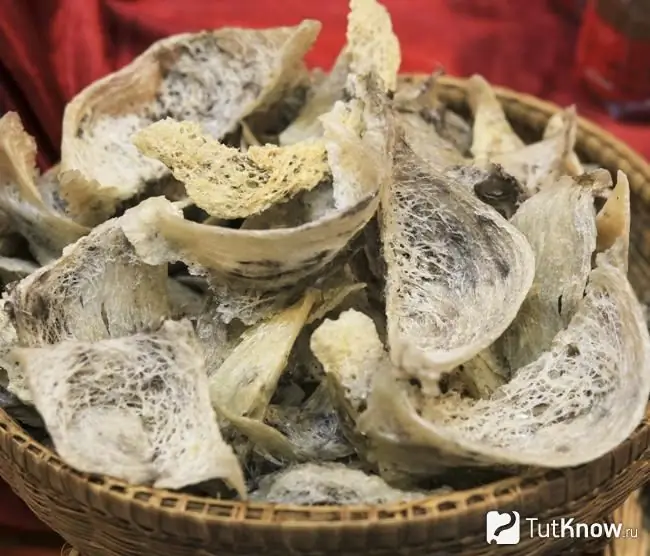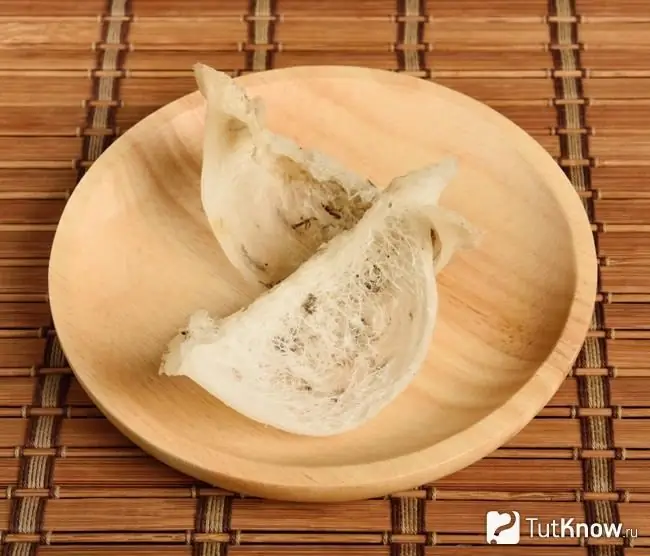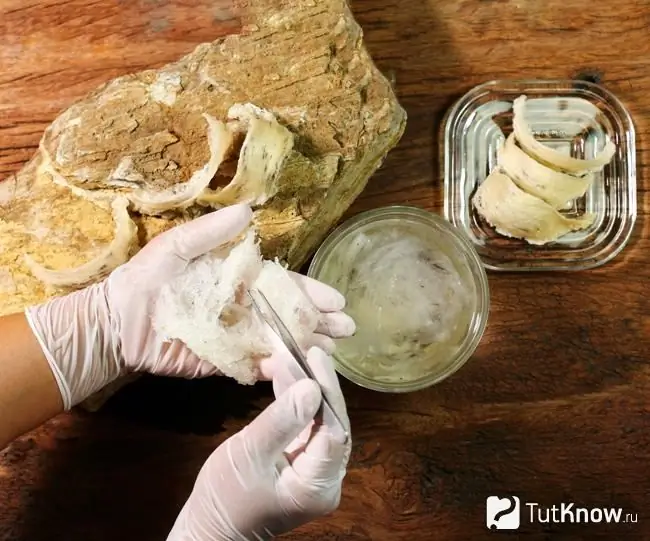What is an edible bird's nest, types and composition. Useful properties and contraindications for use. How is the delicacy eaten? Recipes for swallow's nest soup and other dishes.
Edible birds' nests are one of the most expensive delicacies in the world, a natural product that has many useful properties and an interesting taste. Edible "dwellings" are built by some types of swifts - swiftlets. At the same time, the delicacy is often called the swallow's nest. Indonesia is considered the main supplier. Also, a large number of farms are located in Malaysia, Vietnam, the Philippines. As for the main consumers, they are the Chinese. Less demand for the product in other countries in Southeast Asia and North America. The most popular dish with this ingredient is swallow's nest soup. In addition, it is added to other recipes. More detailed information on the composition of swiftlet nests, useful properties and contraindications for use in this article.
What are edible bird nests?

The photo shows edible bird nests of swiftlet
For a huge number of people, bird nests are not at all associated with a nutritious and tasty lunch. However, Asians and Americans alike have long been aware of the high nutritional value and health benefits of this product. It cannot be attributed to consumer goods, because the cost is quite impressive.
The culture of eating swiftlet nests for food has a long history. The first mentions date back to the 7th century AD. From the very beginning, a rare and very useful product was available only to the imperial families.
Until recently, catching swiftlet nests was laborious and very dangerous because birds in the wild often nest in hard-to-reach places on the slopes of rocks, in caves. However, in the course of the study, the features of their behavior were identified, the imitation of which helped to attract females and males to man-made premises. In them, farmers create suitable microclimate conditions for swifts to comfortably build nests and lay eggs. Thus, farms for the extraction of the swallow's nest appeared. Their number is steadily growing, which makes it possible to increase the annual turnover of this delicacy and gradually reduce the cost.
Classification of edible bird nests of swifts-swifters:
- Bloody … This species is considered the rarest and most expensive. Some believe that this color is due to a lack of saliva in birds and the presence of an admixture of blood. However, this statement is not true. The red tint is due to nutritional characteristics and indicates the presence of more nutrients. Additional enrichment with minerals usually occurs if the bird builds a dwelling to continue offspring in the wild, in particular in mountain caves. The nests are gradually covered with iron and other minerals, which oxidize over time - this is how an interesting shade is obtained. Such nests are collected in Thailand in limestone caves.
- Red … The color can be pinkish brown, pink and orange. Also comes across in the wild. The shade depends on the types and amount of impurities with which the fibers are impregnated.
- White … The most popular and cheapest product, as birds build nests in farm conditions. Such a product is fragrant, fragile and free of impurities. Most often, breeders cut nests before laying eggs, so they are white and clean. Feathers only occasionally come across.
- Gray … The darkened bowls are those in which there were already chicks. They are less valuable, but still go to the entrance. This requires more thorough cleaning.
What the nests are made of, with the help of which the swifts are made, and why they can be eaten are interesting questions. In our area, birds build a dwelling from twigs, leaves, needles. Salanganes use their saliva for this. It is a sticky substance that hardens rather quickly, creating a strong bed. Various seafoods are often used - the finest pieces of algae, fry, molluscs, eggs. Because of this, many attribute the delicacy to seafood.
On average, the wholesale price for 1 kg of white nests is about $ 1200. At retail, the cost rises 2 or more times. So, in an online store, a gourmet product can be bought for 2000-3000 dollars. As for the so-called bloody nests, the cost of a kilogram sometimes reaches 10 thousand dollars.
The price of swallow's nest soup ranges from $ 10-100. Swift saliva drinks start at $ 3.
It is worth noting that unscrupulous sellers artificially tint the product to increase its value, or even imitate it from agar-agar. However, there is a testing system for quality assurance. Therefore, you need to buy a delicacy only from a trusted supplier.
Composition and calorie content of swiftlet nests

Nests exported from Malaysia are considered to be the most useful. There is also evidence that a product that is richer in minerals is one that is harvested from wild places, especially from sheer cliffs. As for farms where swifts live, nests also contain a lot of useful substances and constitute the bulk of the export in this industry.
Taiwanese scientists studied the biochemical composition of the product. According to them, the main component of swiftlet nests is a special biomolecule, glycoprotein, consisting of carbohydrates and protein. This composition is extremely beneficial for the immune system. But the benefits are not limited to this.
The calorie content of an edible bird's nest per 100 g is 281 kcal, of which:
- Protein - 37 g;
- Fat - 0.3 g;
- Carbohydrates - 30 g;
- Fiber - 1, 4 g;
- Water - 24.5 g.
Minerals:
- Iron - 5 g;
- Calcium - 485 mg;
- Phosphorus - 18 mg
The presence of amino acids is also noted in the nests of swiftlets: essential - leucine, valine, threonine, phenylalanine, lysine, isoleucine, methionine, nonessential - tyrosine, serine, arginine, glycine, histidine, cysteine, aspartic and glutamic, proline, alanine.
Useful properties of swiftlet bird nests

Edible swift nests are an incredibly healthy delicacy. They are rich in nutrients and can improve health with continued consumption. It is believed that this product is especially important to eat for children, the elderly, and pregnant women.
The beneficial effect of the edible bird's nest of swifts on the body:
- Gastrointestinal tract … Increases appetite and helps fight anorexia. It also eases the condition and has an antitumor effect in oncology of the larynx, esophagus and intestines. Eating a delicacy is useful for liver cirrhosis, hepatitis B and some kidney diseases.
- Skin … The rejuvenating and regenerating effect has a beneficial effect on the skin. The product allows you to improve the color of the epidermis, reduce the number of wrinkles and prevent premature age-related changes in the structure. The incredible cosmetic effect is highly appreciated by women. With regular consumption of bird's nest meals, the skin receives a sufficient amount of essential vitamins and minerals.
- Respiratory system … Swiftlet nests help protect lung tissue from pathological changes during infectious diseases.
- Immunity … Stimulation of the body's defenses is another useful function of the product. Vitamins help support the body and increase its resistance to various infections. When consumed in small portions, it helps to recuperate after illness and surgery.
- Reproductive system … The product improves potency, prolongs erection, improves sperm quality, which helps in the fight against male infertility.
- Heart and blood vessels … It improves blood circulation, nutrition of cells with oxygen and nutrients. The product helps to stabilize blood pressure and normalize heart function.
- Nervous system and brain … The delicacy improves memory, helps to increase the resistance of the nervous system to various stimuli. Allows you to neutralize the symptoms of stress.
The benefits of swiftlet nests for pregnant women in the 2-3 trimester is manifested in the replenishment of nutrients that are so necessary for hormonal changes and an increase in needs during gestation. Vitamins and minerals have a beneficial effect on the development of the fetus and prevent oxygen starvation and deficiency of essential compounds.
Swift nests are recommended for the prevention and treatment of oncological diseases. The delicacy relieves the patient's condition, prevents complications that usually occur after chemical or radiation therapy. Due to tumors, a person's appetite often deteriorates, and a deficiency of nutrients is manifested. In this case, you need to use the nests in small portions.
Swift dwellings are also useful in the treatment of AIDS.
Due to the wide range of beneficial effects, the product is not only eaten, but also made from the swiftlet nest extract, on the basis of which cosmetics and medicines are made.
Contraindications and harm to an edible bird's nest

Eating bird nests, of course, allows you not only to satisfy your hunger, but also to get a lot of nutrients necessary to maintain health. Along with this, not everyone is recommended to eat them. Moreover, in some situations, you should completely abandon this delicacy.
Contraindications to the use of the swallow's nest:
- Malabsorption … With metabolic disorders, a decrease in the activity of the spleen, many useful substances are not absorbed by the body. In such cases, the use of a product rich in nutrients can lead to increased stress on the digestive system.
- Weakened in disease state … Despite the fact that the product is very nutritious, it should not be eaten during a severe cold with fever, severe headache, and acute bronchitis. Also contraindications are indigestion, dermatitis and urinary tract infections. The reason for this is the fact that digestion of the swiftlet bird's nest requires a lot of energy costs, which contributes to an even greater weakening of the body. During many diseases, food should be light and well absorbed.
- Children up to age 1 year … In infancy, the digestive system is still poorly developed, therefore, such a complex product will greatly overload the gastrointestinal tract and can provoke indigestion.
- Depression … A severe mental disorder negatively affects the work of the whole body, including provoking malabsorption, which was mentioned above. That is why, during depression, you should refuse to use bird's nest soup prepared according to any recipe.
- First trimester of pregnancy … During this period of development, the fetus is too vulnerable, therefore, it is not advisable to introduce a delicacy into a woman's diet.
How do bird nests eat?

The photo shows how to clean bird nests before cooking
Some delicacies are distinguished by an interesting bright taste, others amaze with their unusual taste, and still others cause ambiguous feelings, sometimes not even the most pleasant ones. As for the nest created by the swift swift, we are not talking about any special sensations. It does not have a pronounced taste and smell, and after cooking, it resembles jelly in texture.
Before eating, the product must be prepared in such a way as to preserve the maximum useful properties. And there is a special technology for this. It is noteworthy that boiling and heating in the microwave reduces the nutritional value and makes the swallow's nest completely tasteless.
Bird's nest processing technology:
- Outwardly, the product resembles a spider web vermicelli, which may contain feathers, droppings and other foreign elements. You need to get rid of such garbage. What cannot be removed at this stage can be removed after further processing.
- Then the nest must be placed in a deep plate and filled with hot water. Within 5 hours, it is necessary to drain the cooled liquid and refill with a clean hot one. During this time, the "cobweb" swells. In this case, the product can increase several times.
- The next stage is treatment with an alkaline solution. First, we dilute a little soda in warm water and fill the nests. After a few minutes, drain all the liquid and rinse with running water.
- It should be brought to readiness in a water bath, so that vigorous boiling does not destroy nutrients.
It is recommended to eat dishes with swiftlet nests no more than 2 times a week. The best time for this is morning and evening, when the body is able to assimilate the maximum amount of minerals and vitamins. The portions should be small so as not to overload the digestive system.
Store the product that has not yet been processed in a cool, dry and dark place, but not in the refrigerator. The shelf life is from 3 months to a couple of years. Cleaned and treated nests can be placed in the freezer in individually wrapped portions and stored for up to 1 year. When stored in the refrigerator, the finished product is edible for 2 weeks.
Swallow's Nest Recipes

Photo of swallow's nest soup
Since the moment when the nutritional and beneficial properties of the secluded houses of swifts-swifters were discovered, many recipes for the preparation of this exotic product have appeared in cooking. Of course, liquid food remains the most popular, and in any Asian country, bird's nest soup is prepared according to its own recipe - for different tastes and preferences.
To make the swiftlet nests tastier, add warm milk or chicken broth to them. Also, salt or sugar, monosodium glutamate is used to improve the taste. The product goes well with cordyceps, chia and lotus seeds, almond sugar, honey, wine alcohol and rice vodka, apples, pigeon meat and even coconut.
Delicious recipes:
- Lobster and Swallow's Nest with Egg White … Ingredients: lobster fillet (140 g), crab meat (60 g), crab caviar (40 g), egg white (120 g), swallow's nest (40 g), creamy chicken broth sauce (120 ml), chicken powder (1/6 tsp), bamboo (60 g), salt (1/6 tsp). First, we process the bird's nests. Marinate lobster meat: for this you can simply use salt or make a marinade and garlic, lemon juice and soy sauce. Then quickly fry. Pour crab caviar with hot water and leave for a while until it reaches 70% readiness. We steam the protein with warm water for 10 minutes so that it grabs, drain the water and put it on a plate. Mix the meat, crab caviar, swallow's nest and sauce. Put it on a plate along with the lobster. Add boiled bamboo. A gorgeous gourmet meal ready to serve!
- Bird's nest soup … Ingredients: dried salangan houses (100 g), chicken broth (400 ml), chicken fillet (400 g), corn starch (2 tablespoons), dry sherry (1 tablespoon), egg white (2 pcs.), salt (1 tsp), ham (100 g), green onions (50 g). First you need to prepare the bird's nests and boil them in chicken broth in a water bath for about 30 minutes. Pass the chicken fillet through a meat grinder, add starch and a little broth, so that after mixing, a viscous mass is obtained. Add sherry and beaten egg whites. The resulting mass is gradually added to the hot broth with nests. It is important to do this slowly so that the liquid does not cool down. When ready, put in plates, sprinkle with chopped onions and ham. For this swallow's nest soup recipe, you can use boiled rice as a side dish.
- Edible Swallow's Nest Jelly … Making a treat is pretty simple. To do this, we process the product according to technology, and then place it in a water bath with a minimum amount of water and sugar. We boil for at least 20 minutes and bring to readiness and obtain the required viscous consistency. We cool it down.
- Sweet swallow's nest soup … Ingredients: swiftlet nests (20 g), almonds (20 g), honey (to taste), dried berries or dates (40-80 g). We clean the houses of the swifts, soak them for 5 hours, and then boil them with a little water in a water bath. After 20 minutes add berries, almonds and honey. Bring on low heat until cooked and put in the soup tureens. Sprinkle with coconut if desired.
How to make soup from a swallow's nest - watch the video:

The fishery for swallow nests is incredibly profitable, so the volumes of the extracted raw materials are gradually increasing, and at the same time the competition is growing. Perhaps, with the further development of the industry, prices for this delicacy will decrease and it will become more accessible to more people.






